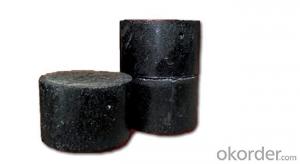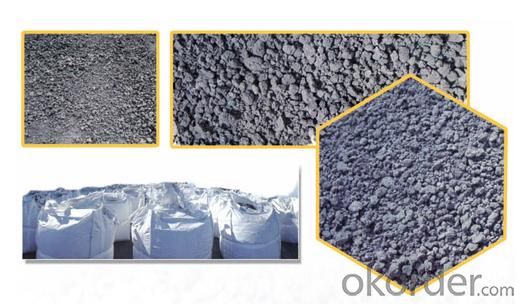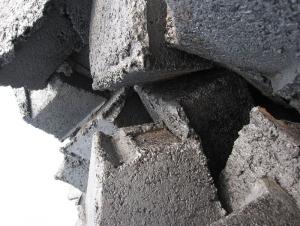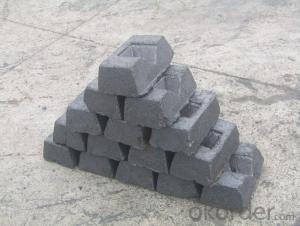Cylinder Carbon Electrode Paste With Dia 500/60MM
- Loading Port:
- Lianyungang
- Payment Terms:
- TT OR LC
- Min Order Qty:
- 20 m.t.
- Supply Capability:
- 800 m.t./month
OKorder Service Pledge
OKorder Financial Service
You Might Also Like
Cylinder Carbon Electrode Paste With Dia 500/60MM
Product Description
Carbon Electrode Paste is a self-baking electrode used in submerged arc furnaces for delivering power to the charge mix. Electrode Paste is added to the top of the electrode column in either cylindrical or briquette form. As the paste moves down the electrode column the temperature increase causes the paste to melt and subsequently bake forming a block of electrically conductive carbon. Electrode Paste is essentially a mix of Electrically Calcined Anthracite (ECA) or Calcined Petroleum Coke (CPC) with Coal Tar Pitch.
Features
1:carbon eletrode paste
2:for ferroalloy,calcium carbide manufacture
3:HS 3801300000,YB/T5212-1996,ISO9001:2008
Graphite/Carbon Electrode Paste Specification
| PARAMETER UNIT GUARANTEE VALUE | ||||||
| Ash.( % ) | 4.0 max | 5.0 max | 6.0 max | 7.0 max | 9.0 max | 11.0 max |
| V.M (%) | 12.0-15.5 | 12.0-15.5 | 12.0-15.5 | 9.5-13.5 | 11.5-15.5 | 11.5-15.5 |
| Compress Strength. | 18.0 min | 17.0 min | 15.7 min | 19.6 min | 19.6 min | 19.6 min |
| Specific Resistance | 65 max | 68 max | 75 max | 80 max | 90 max | 90 max |
| Bulk Density | 1.38 min | 1.38 min | 1.38 min | 1.38 min | 1.38 min | 1.38 min |
Picture
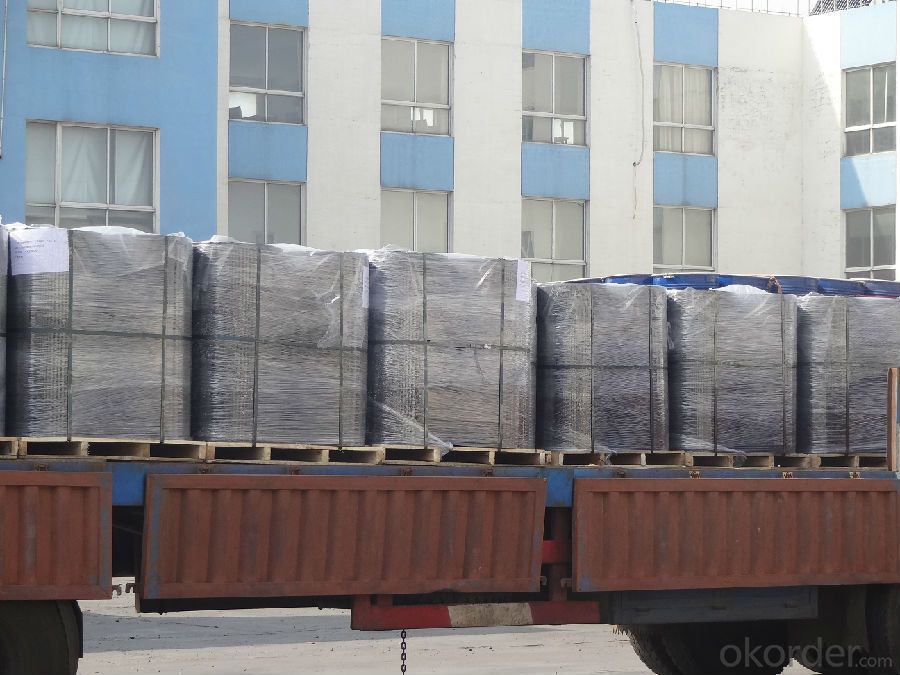
- Q: How does carbon dating work?
- Carbon dating is a scientific technique used to determine the age of organic materials, such as plants, animals, and human remains. It relies on the fact that carbon-14, a radioactive isotope of carbon, is constantly formed in the atmosphere by cosmic rays. While carbon-14 is present in the atmosphere, it is also absorbed by living organisms through photosynthesis or consumption of other organisms. The ratio of carbon-14 to stable carbon isotopes (carbon-12 and carbon-13) in the atmosphere remains relatively constant, as living organisms maintain a constant level of carbon-14 by exchanging it with the atmosphere through respiration or consumption. However, when an organism dies, it no longer takes in carbon-14, and the existing carbon-14 begins to decay at a predictable rate. Carbon-14 has a half-life of approximately 5,730 years, meaning that after this time, half of the carbon-14 in a sample will have decayed into nitrogen-14. By measuring the remaining carbon-14 in a sample, scientists can calculate how long it has been since the organism died. The process of carbon dating involves several steps. First, a sample is collected from the organic material to be dated, which can be anything from wood to bones to textiles. The sample is then prepared for analysis by removing any contaminants and converting it into a form suitable for measurement. Next, the sample is exposed to a high-energy radiation source, such as a particle accelerator or a nuclear reactor, which causes the carbon atoms in the sample to release small bursts of energy known as beta particles. These particles are detected and measured by sensitive instruments, allowing scientists to determine the amount of carbon-14 remaining in the sample. Finally, this information is used to calculate the age of the organic material. By comparing the ratio of carbon-14 to carbon-12 in the sample to the known ratio in the atmosphere, scientists can estimate the time elapsed since the organism died. Carbon dating is an invaluable tool for archaeologists, paleontologists, and geologists, as it allows them to accurately determine the ages of ancient artifacts, fossils, and geological formations. It has revolutionized our understanding of human history and the natural world, providing us with invaluable insights into the past.
- Q: How does carbon affect the formation of acidification in lakes?
- Carbon dioxide (CO2) plays a significant role in the formation of acidification in lakes. When carbon dioxide is released into the atmosphere through various human activities, such as burning fossil fuels, it can be absorbed by water bodies like lakes. This absorption leads to the formation of carbonic acid (H2CO3), a weak acid. Carbonic acid dissociates into hydrogen ions (H+) and bicarbonate ions (HCO3-) in water. The increase in hydrogen ions causes a decrease in pH levels, making the water more acidic. This process is known as acidification. Acidification in lakes can have detrimental effects on aquatic ecosystems. It affects the physiology and behavior of many species, including fish, amphibians, and invertebrates. Acidic waters can also damage the eggs and larvae of these organisms, hindering their growth and survival. Additionally, acidification can alter the composition and abundance of phytoplankton, which are crucial for the overall health of the ecosystem. High levels of acidity can also lead to the leaching of toxic metals, such as aluminum, from the surrounding soil and rocks. These toxic metals are then dissolved in the water, posing an additional threat to aquatic organisms. Acidification can also disrupt the nutrient cycles in lakes, affecting the availability of essential nutrients for plants and animals. In summary, the presence of carbon dioxide in the atmosphere contributes to the acidification of lakes when it is absorbed by water. This acidification has a range of negative impacts on the aquatic ecosystem, including altered physiology, impaired reproduction, and disrupted nutrient cycles. It is crucial to reduce carbon emissions and mitigate the effects of acidification to protect the health and diversity of lake ecosystems.
- Q: What is carbon neutral certification?
- The process of carbon neutral certification involves evaluating and verifying organizations, products, or services to ensure they have a carbon footprint that equals zero. This requires taking significant measures to reduce greenhouse gas emissions and offsetting any remaining emissions through the purchase of carbon credits or investments in projects that remove carbon dioxide from the atmosphere. To achieve carbon neutrality, entities undergo a thorough assessment that measures their carbon emissions, sets reduction targets, implements initiatives to reduce their carbon footprint, and tracks progress. After reducing emissions as much as possible, any remaining emissions are offset by investing in verified projects such as reforestation, renewable energy, or energy efficiency projects that reduce greenhouse gases. Certification is conducted by an independent third-party organization to evaluate and verify carbon neutrality claims, ensuring transparency and credibility. Once certified, organizations or products can display the carbon neutral label to demonstrate their commitment to environmental sustainability and responsible carbon management. Carbon neutral certification is crucial as it offers a standardized and recognized method for organizations and products to showcase their dedication to combating climate change. It enables consumers and stakeholders to make informed choices by supporting entities that have taken concrete steps to reduce their carbon emissions and contribute to a more sustainable future. Moreover, carbon neutral certification encourages organizations to adopt sustainable practices and invest in environmentally positive projects, thus hastening the transition to a low-carbon economy.
- Q: What are the properties of carbon fibers?
- Carbon fibers possess a range of remarkable attributes, rendering them a distinctive and adaptable material. One noteworthy characteristic is their exceptional strength-to-weight ratio. Carbon fibers exhibit tremendous strength, often surpassing that of steel, while also being significantly lighter. This quality makes them exceptionally well-suited for industries such as aerospace and automotive, where high strength and low weight are essential. Another significant attribute of carbon fibers is their stiffness. They possess a high degree of rigidity, ensuring minimal deformation when subjected to applied loads. This property proves advantageous in applications that require stability and rigidity, such as the construction of sporting goods like tennis rackets or golf clubs. Additionally, carbon fibers display outstanding resistance to chemical corrosion. They exhibit a high level of resistance to the detrimental effects of chemicals or corrosive substances, making them highly suitable for use in harsh environments. Industries such as chemistry or offshore structures prefer carbon fibers due to this property. Furthermore, carbon fibers have a low thermal expansion coefficient, indicating minimal expansion when exposed to heat. This characteristic is vital in applications where thermal stability is crucial, such as the manufacturing of high-temperature components like turbine blades or heat shields. Moreover, carbon fibers possess excellent fatigue resistance, enabling them to endure repeated loading and unloading cycles without significant damage. This attribute is particularly advantageous in applications subjected to cyclic or dynamic stresses, including the construction of sports equipment or aerospace structures. Lastly, carbon fibers exhibit excellent electrical conductivity. They efficiently conduct electricity, making them suitable for applications that require electrical conductivity, such as lightning strike protection in the aerospace industry or the production of electronic devices. In summary, the high strength-to-weight ratio, stiffness, chemical resistance, low thermal expansion, fatigue resistance, and electrical conductivity of carbon fibers establish them as a highly sought-after material in various industries.
- Q: What are the impacts of carbon emissions on the stability of mangroves?
- Carbon emissions have detrimental effects on the stability of mangroves, which are crucial coastal ecosystems. The increased levels of carbon dioxide (CO2) in the atmosphere contribute to global warming, leading to rising sea levels and increased frequency and intensity of storms. These changes directly impact the stability of mangroves in several ways. Firstly, rising sea levels caused by global warming can result in increased inundation of mangroves. As the sea level rises, saltwater intrusion occurs more frequently, affecting the delicate balance of saltwater and freshwater in mangrove ecosystems. This can lead to the displacement and decline of mangroves, as they struggle to adapt to the changing conditions. Secondly, the increased frequency and intensity of storms associated with climate change can cause physical damage to mangroves. Mangroves act as a natural barrier, protecting coastlines from storm surges by absorbing wave energy. However, with stronger storms, the resilience of mangroves is tested, and they may be uprooted or destroyed, leaving the coastlines vulnerable to erosion and further damage. Furthermore, carbon emissions are also linked to ocean acidification, which occurs as the excess CO2 in the atmosphere is absorbed by the oceans. Acidic waters can negatively impact the growth and development of mangroves, as they are sensitive to changes in pH levels. This can lead to reduced productivity, stunted growth, and even death of mangroves, further destabilizing these ecosystems. The stability of mangroves is vital for both the environment and human populations. Mangroves provide essential habitat for various species, serving as a nursery for fish and supporting biodiversity. They also act as carbon sinks, sequestering significant amounts of CO2 from the atmosphere. Additionally, mangroves play a crucial role in coastal protection, mitigating the impacts of erosion, storm surges, and flooding. To mitigate the impacts of carbon emissions on the stability of mangroves, it is crucial to reduce greenhouse gas emissions and limit global warming. This can be achieved through the adoption of clean energy sources, conservation efforts, and reforestation initiatives. Protecting and restoring mangrove habitats is equally important, as it helps maintain their stability and resilience to climate change impacts.
- Q: Material characteristics of carbon fiber
- This allows carbon fibers to have the highest specific strength and specific modulus in all high-performance fibers. Compared with the metal materials such as titanium, steel and aluminium, carbon fiber has the characteristics of high strength, high modulus, low density and low coefficient of linear expansion. It can be called the "king of new materials". In addition to carbon fiber with general characteristics of carbon material, its appearance has obvious anisotropy and soft, can be processed into a variety of fabrics, and the proportion of small, along the fiber axis show a very high strength carbon fiber reinforced epoxy resin composites, the strength and modulus of composite indicator in the existing structural materials is the highest. The tensile strength of carbon fiber resin composite materials are generally in more than 3500 MPa, is 7 to 9 times that of steel, the tensile modulus of 230 to 430G were also higher than that of steel; therefore the specific strength of CFRP material intensity and density can be achieved above 2000 MPa, the specific strength of A3 steel is only 59 MPa.
- Q: How does carbon affect the electrical conductivity of materials?
- The electrical conductivity of materials can be significantly affected by carbon due to its unique electronic properties. Carbon atoms can form various allotropes, including graphite, diamond, and fullerenes, each having distinct electrical conductive properties. Take graphite, for example. It consists of carbon atoms arranged in a hexagonal lattice structure, forming strong covalent bonds within each layer. However, weak van der Waals forces exist between the layers, allowing electrons to move easily in the plane of the layers. This delocalization of electrons in graphite contributes to its high electrical conductivity, as the free electrons can move freely and carry electrical charges. On the other hand, diamond, another form of carbon, has a three-dimensional covalent network structure. Each carbon atom forms four strong covalent bonds with neighboring atoms, resulting in a highly rigid and stable lattice. The absence of free electrons in diamond restricts the movement of electrical charges, making it an insulator. The electrical conductivity of fullerenes, which are spherical carbon molecules, can vary depending on their structure. Some fullerenes can act as semiconductors, meaning their electrical conductivity can be controlled by introducing impurities or applying external stimuli. Furthermore, carbon can be used as a dopant in certain materials to enhance their electrical conductivity. For instance, adding small amounts of carbon to silicon can improve its electrical conductivity, making it suitable for electronic devices. In conclusion, carbon's impact on electrical conductivity relies heavily on its structure and arrangement within a material. Understanding the different forms and properties of carbon allows engineers and scientists to design materials with desired electrical conductive characteristics for various applications.
- Q: How is carbon used in the production of carbon nanowires?
- Carbon is a key component in the production of carbon nanowires due to its unique properties. Carbon nanowires are typically created through a process called chemical vapor deposition (CVD), which involves the decomposition of a carbon-containing precursor gas in a high-temperature environment. In this process, a carbon source, such as methane or ethylene, is introduced into a reaction chamber. The precursor gas is then heated to a high temperature, typically above 600 degrees Celsius, which causes it to decompose. As a result, carbon atoms are released and start to deposit on a substrate material, such as a silicon wafer or a metal catalyst. The carbon atoms in the precursor gas have a tendency to form strong covalent bonds with each other, leading to the formation of a graphite-like structure. However, by carefully controlling the growth conditions, such as temperature and pressure, the deposited carbon atoms can be made to arrange themselves in a highly ordered manner, forming nanowires. The use of carbon as the building block for nanowires is advantageous due to its exceptional thermal and electrical conductivity, as well as its high mechanical strength. This allows carbon nanowires to exhibit unique properties, making them suitable for various applications, such as in electronics, energy storage, and sensors. Overall, carbon plays a crucial role in the production of carbon nanowires by serving as the raw material that undergoes decomposition and subsequent rearrangement to form the desired nanoscale structures.
- Q: How is carbon used in the production of paints?
- Carbon is used in the production of paints in several ways. One of the main uses of carbon in paint production is as a pigment. Carbon black, which is a form of elemental carbon, is commonly used as a black pigment in various types of paints. It provides a deep and intense black color, as well as excellent light absorption properties, making it ideal for creating dark shades in paints. Carbon also plays a role in the formulation of certain types of paints, such as carbon-based coatings. These coatings are used in applications where resistance to heat, chemicals, and corrosion is required. Carbon-based coatings are often used in industries like automotive, aerospace, and marine, where durability and protection are crucial. These coatings can be applied to various surfaces, providing a high level of protection and extending the lifespan of the painted object. In addition, carbon is used as a filler material in some types of paints. Carbon fillers are added to improve the mechanical properties of the paint, such as its strength, hardness, and resistance to wear and tear. Carbon fillers also enhance the overall performance of the paint, making it more durable and long-lasting. Overall, carbon is an essential ingredient in the production of paints, serving as a pigment, a component of coatings, and a filler material. Its versatile properties make it a valuable addition to various paint formulations, enhancing the aesthetic appeal, durability, and performance of the final product.
- Q: Today in the market to buy Yuba, instructions have such a word that I don't understand, please master Zhijiao: carbon fiber after energized carbon molecule formation of Brown movement, this movement can be effective in most of the electrical energy into the far infrared.
- When it is energized, its motion intensifies, the frequency becomes V2, and the frequency becomes larger, the vibration system is unstable and the frequency is back to its original frequency. So you have to release energy in the form of electromagnetic waves. I am not too clear about the specific release process. I know that the molecules do slow motion and generate additional electromagnetic waves. The frequency of the extra electromagnetic wave emitted is v2-v1, and its frequency falls in the far infrared region.
Send your message to us
Cylinder Carbon Electrode Paste With Dia 500/60MM
- Loading Port:
- Lianyungang
- Payment Terms:
- TT OR LC
- Min Order Qty:
- 20 m.t.
- Supply Capability:
- 800 m.t./month
OKorder Service Pledge
OKorder Financial Service
Similar products
Hot products
Hot Searches
Related keywords
